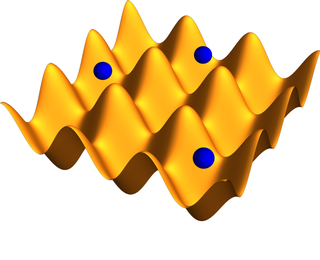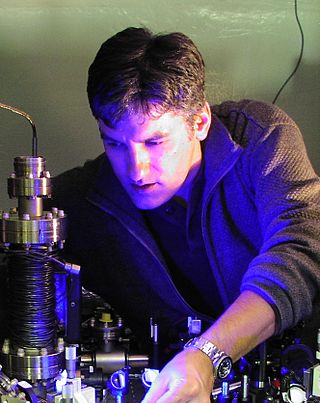
A quantum computer is a computer that takes advantage of quantum mechanical phenomena.
This is a timeline of quantum computing.

A trapped-ion quantum computer is one proposed approach to a large-scale quantum computer. Ions, or charged atomic particles, can be confined and suspended in free space using electromagnetic fields. Qubits are stored in stable electronic states of each ion, and quantum information can be transferred through the collective quantized motion of the ions in a shared trap. Lasers are applied to induce coupling between the qubit states or coupling between the internal qubit states and the external motional states.

An optical lattice is formed by the interference of counter-propagating laser beams, creating a spatially periodic polarization pattern. The resulting periodic potential may trap neutral atoms via the Stark shift. Atoms are cooled and congregate at the potential extrema. The resulting arrangement of trapped atoms resembles a crystal lattice and can be used for quantum simulation.

Nuclear magnetic resonance quantum computing (NMRQC) is one of the several proposed approaches for constructing a quantum computer, that uses the spin states of nuclei within molecules as qubits. The quantum states are probed through the nuclear magnetic resonances, allowing the system to be implemented as a variation of nuclear magnetic resonance spectroscopy. NMR differs from other implementations of quantum computers in that it uses an ensemble of systems, in this case molecules, rather than a single pure state.
Quantum annealing (QA) is an optimization process for finding the global minimum of a given objective function over a given set of candidate solutions, by a process using quantum fluctuations. Quantum annealing is used mainly for problems where the search space is discrete with many local minima; such as finding the ground state of a spin glass or the traveling salesman problem. The term "quantum annealing" was first proposed in 1988 by B. Apolloni, N. Cesa Bianchi and D. De Falco as a quantum-inspired classical algorithm. It was formulated in its present form by T. Kadowaki and H. Nishimori in 1998 though an imaginary-time variant without quantum coherence had been discussed by A. B. Finnila, M. A. Gomez, C. Sebenik and J. D. Doll in 1994.
In condensed matter physics, an ultracold atom is an atom with a temperature near absolute zero. At such temperatures, an atom's quantum-mechanical properties become important.
A quantum bus is a device which can be used to store or transfer information between independent qubits in a quantum computer, or combine two qubits into a superposition. It is the quantum analog of a classical bus.
Adiabatic quantum computation (AQC) is a form of quantum computing which relies on the adiabatic theorem to perform calculations and is closely related to quantum annealing.
The toric code is a topological quantum error correcting code, and an example of a stabilizer code, defined on a two-dimensional spin lattice. It is the simplest and most well studied of the quantum double models. It is also the simplest example of topological order—Z2 topological order (first studied in the context of Z2 spin liquid in 1991). The toric code can also be considered to be a Z2 lattice gauge theory in a particular limit. It was introduced by Alexei Kitaev.

In condensed matter physics, a time crystal is a quantum system of particles whose lowest-energy state is one in which the particles are in repetitive motion. The system cannot lose energy to the environment and come to rest because it is already in its quantum ground state. Time crystals were first proposed theoretically by Frank Wilczek in 2012 as a time-based analogue to common crystals – whereas the atoms in crystals are arranged periodically in space, the atoms in a time crystal are arranged periodically in both space and time. Several different groups have demonstrated matter with stable periodic evolution in systems that are periodically driven. In terms of practical use, time crystals may one day be used as quantum computer memory.

Christopher Roy Monroe is an American physicist and engineer in the areas of atomic, molecular, and optical physics and quantum information science, especially quantum computing. He directs one of the leading research and development efforts in ion trap quantum computing. Monroe is the Gilhuly Family Presidential Distinguished Professor of Electrical and Computer Engineering and Physics at Duke University and is College Park Professor of Physics at the University of Maryland and Fellow of the Joint Quantum Institute and Joint Center for Quantum Computer Science. He is also co-founder of IonQ, Inc.

Quantum machine learning is the integration of quantum algorithms within machine learning programs.
In quantum computing, a qubit is a unit of information analogous to a bit in classical computing, but it is affected by quantum mechanical properties such as superposition and entanglement which allow qubits to be in some ways more powerful than classical bits for some tasks. Qubits are used in quantum circuits and quantum algorithms composed of quantum logic gates to solve computational problems, where they are used for input/output and intermediate computations.
Shortcuts to adiabaticity (STA) are fast control protocols to drive the dynamics of system without relying on the adiabatic theorem. The concept of STA was introduced in a 2010 paper by Xi Chen et al. Their design can be achieved using a variety of techniques. A universal approach is provided by counterdiabatic driving, also known as transitionless quantum driving. Motivated by one of authors systematic study of dissipative Landau-Zener transition, the key idea was demonstrated earlier by a group of scientists from China, Greece and USA in 2000, as steering an eigenstate to destination. Counterdiabatic driving has been demonstrated in the laboratory using a time-dependent quantum oscillator.
Adolfo del Campo is a Spanish physicist and a professor of physics at the University of Luxembourg. He is best known for his work in quantum control and theoretical physics. He is notable as one of the pioneers of shortcuts to adiabaticity. He was elected as a Fellow of the American Physical Society in 2023.
This glossary of quantum computing is a list of definitions of terms and concepts used in quantum computing, its sub-disciplines, and related fields.
Quantum computational chemistry is an emerging field that exploits quantum computing to simulate chemical systems. Despite quantum mechanics' foundational role in understanding chemical behaviors, traditional computational approaches face significant challenges, largely due to the complexity and computational intensity of quantum mechanical equations. This complexity arises from the exponential growth of a quantum system's wave function with each added particle, making exact simulations on classical computers inefficient.








